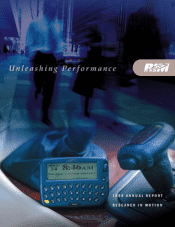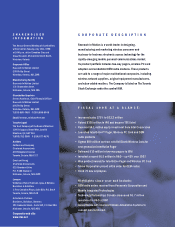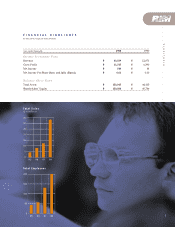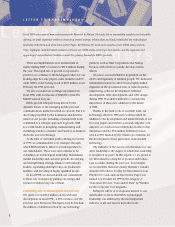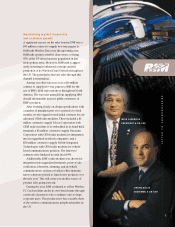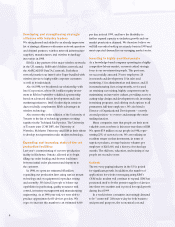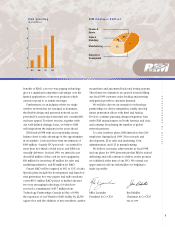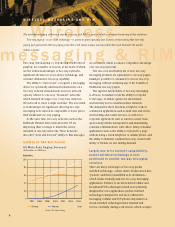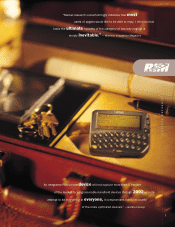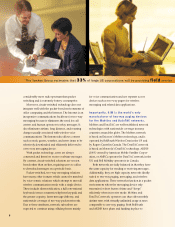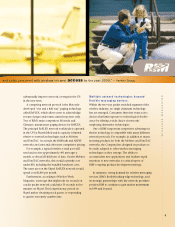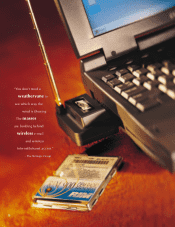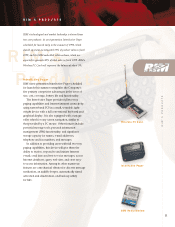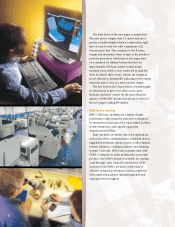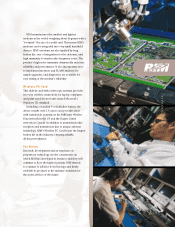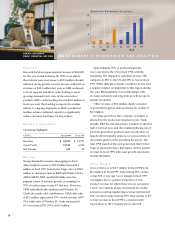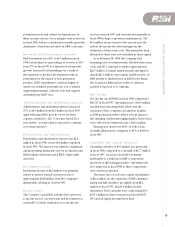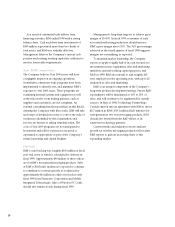Blackberry 1998 Annual Report Download - page 8
Download and view the complete annual report
Please find page 8 of the 1998 Blackberry annual report below. You can navigate through the pages in the report by either clicking on the pages listed below, or by using the keyword search tool below to find specific information within the annual report.
Wireless
messaging & RIM
WIRELESS MESSAGING AND RIM
Two-way messaging is replacing traditional
paging for a number of reasons, at the heart of which
are the technical advantages of two-way networks,
significant advances in access device technology, and
customer demand for two-way capability.
The ability to “narrowcast”, or register a messaging
device for specifically addressed transmissions, on a
two-way network tremendously increases network
capacity relative to one-way “broadcast” networks
which transmit messages over every base station in
the network to reach a single customer. The associated
cost advantages are significant, allowing two-way
messaging to be offered at comparable or lower prices
than traditional one-way paging.
At the same time, two-way networks such as the
BellSouth Wireless Data network in the US are
improving their coverage to match the service
standard of one-way networks. These networks
also offer “store and forward” ability so that messages
are never lost, which is a major competitive advantage
over one-way networks.
The size, cost, and battery life of new two-way
messaging products are equivalent to one-way pagers,
making it possible for consumers to choose two-way
messaging without sacrificing any of the benefits of
traditional one-way pagers.
The superior functionality of two-way messaging
is obvious. Consumers want the ability to respond
to messages, to initiate queries for information,
and remotely access e-mail and office intranets.
The demand for these functions is high for vertical
commercial applications such as field sales and service
and trucking and courier services; as well as for
corporate applications such as wireless e-mail, stock
quotes and portfolio management, and maintaining
constant communications with others. Many consumer
applications such as the ability to respond to a page
without using a wired telephone or cellular phone, and
the ability to maintain continual two-way contact with
family or friends are also fueling demand.
Largely due to its Internet-compatibility,
packet-switched technology is best
positioned to provide two-way messaging
solutions.
There are many advantages of two-way packet
switched technology – where data is broken down into
“packets” and then reassembled at its destination –
which render it ideally suited to two-way messaging
applications. Relative to circuit-switched cellular and
broadband PCS technologies which were primarily
designed for voice applications, packet-switched
technology is inexpensive and more efficient for
messaging. Cellular and PCS phones dependent on
circuit-switched technologies must transmit and
receive constantly during a call session, which occupies
6
The wireless messaging industry is rapidly evolving, and RIM is positioned to be a primary beneficiary of this evolution.
Two-way paging – a core RIM technology – is poised to grow especially fast. Experts are forecasting that two-way
paging and guaranteed delivery paging subscribers will easily surpass one-way subscribers and dominate the market
within a decade.
0
20
40
60
80
100
1997 1998 1999 2000 2001 2002 2003
One-way Two-way Total
Source: The Yankee Group
Subscribers
GROWTH OF TWO-WAY PAGING
US Wide Area Paging Forecast
(Subscribers in Millions)

